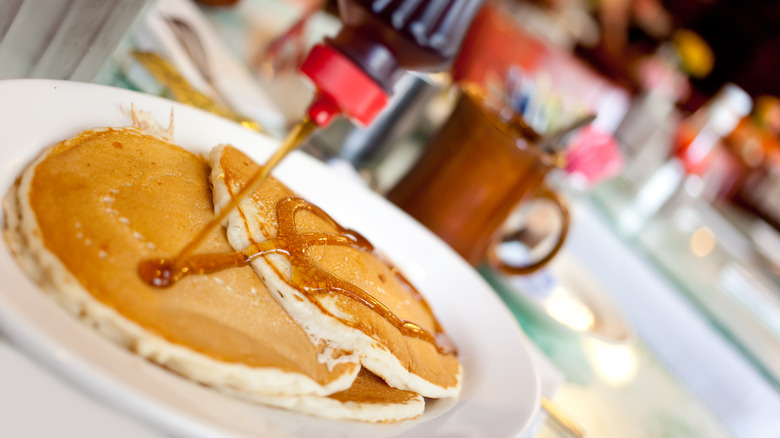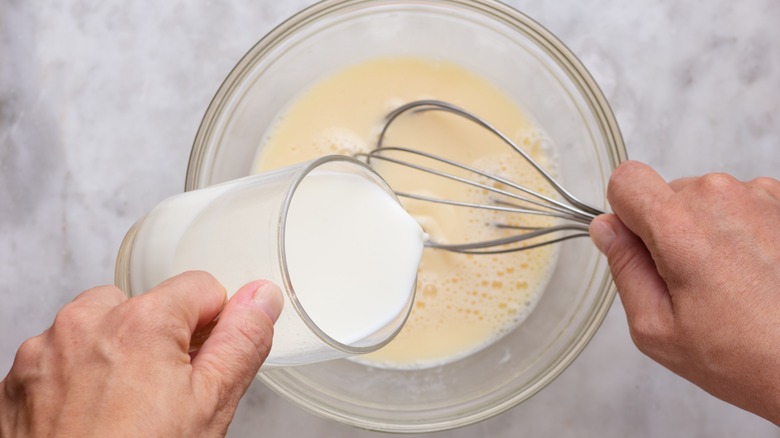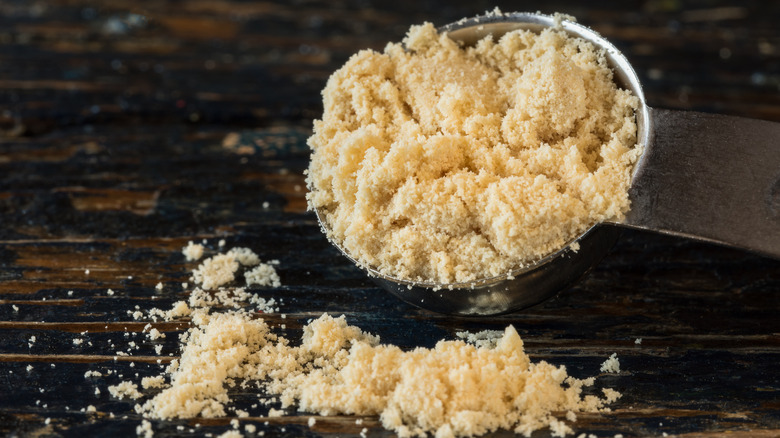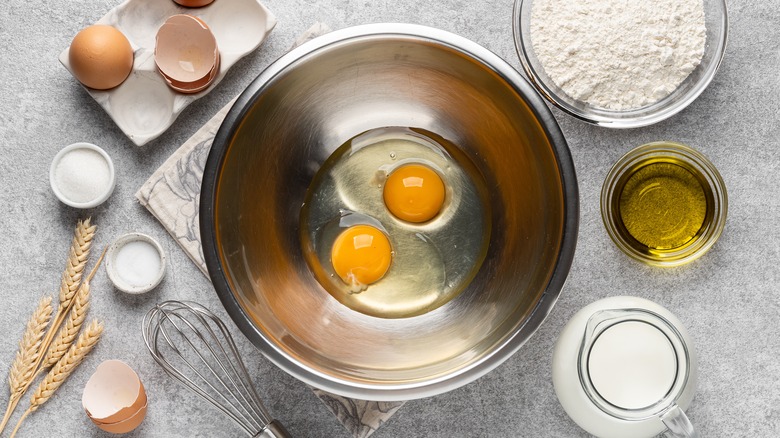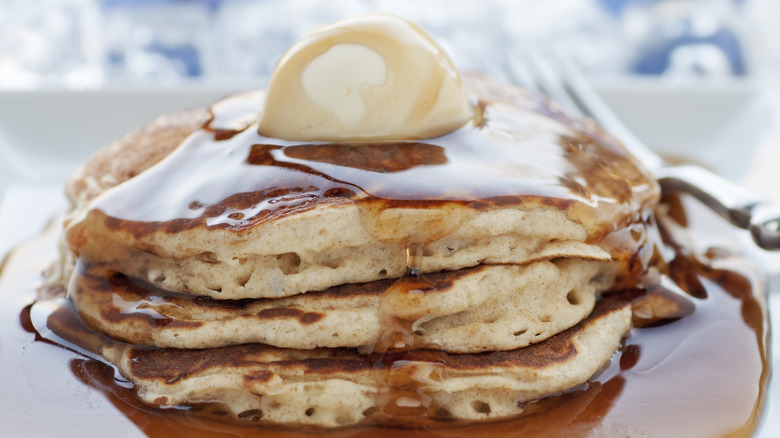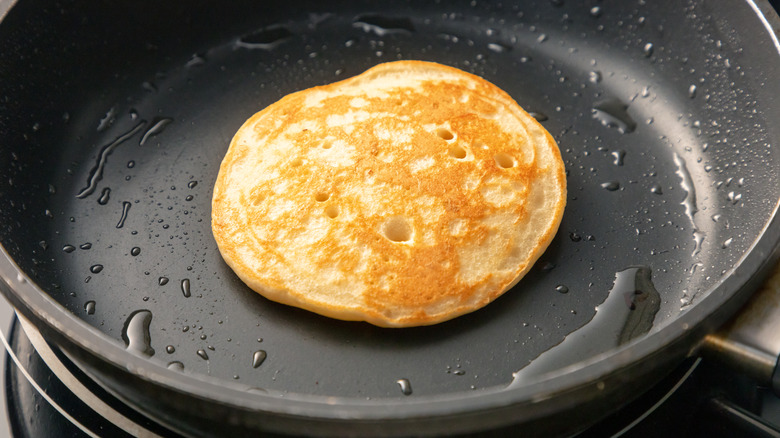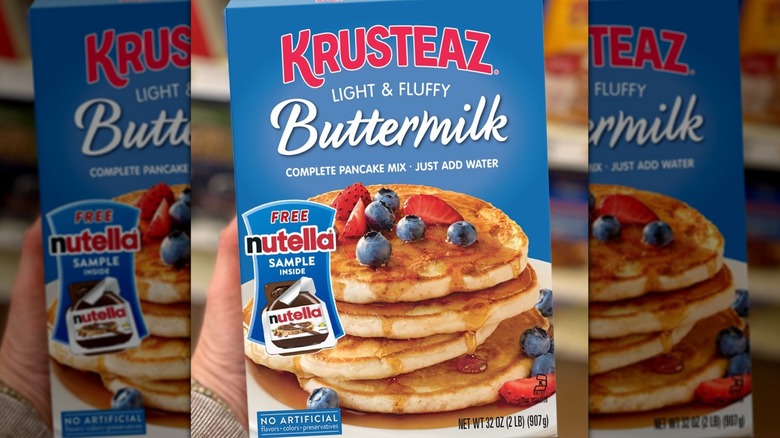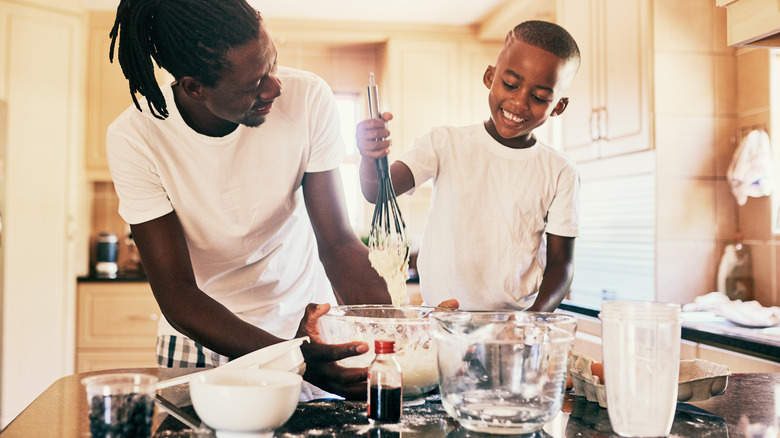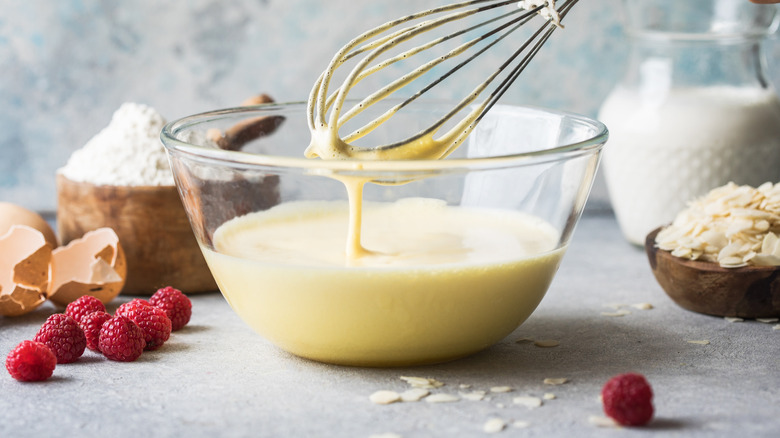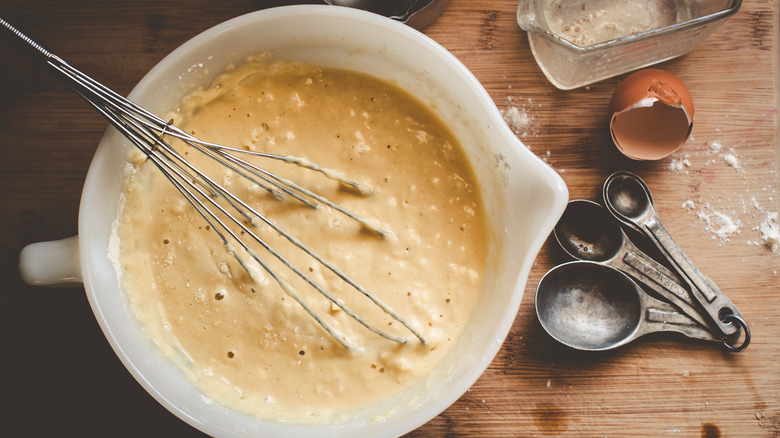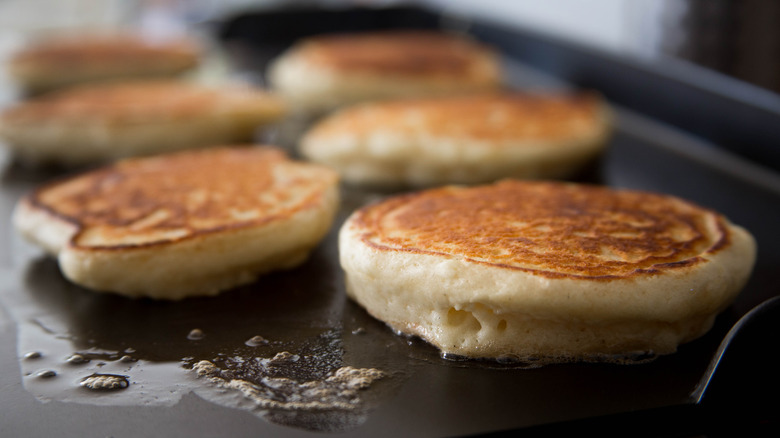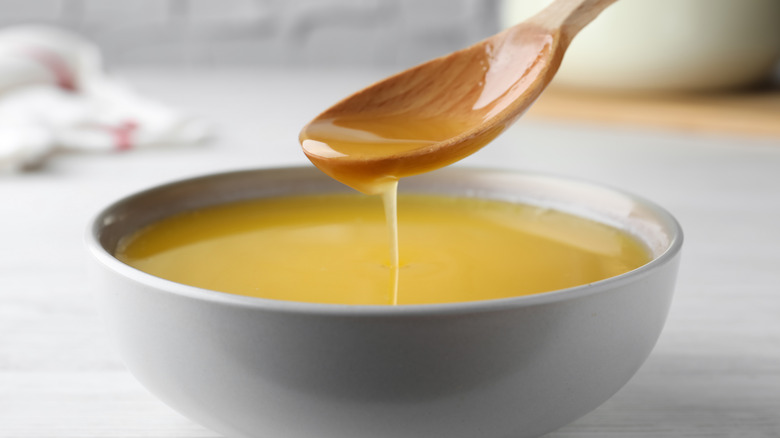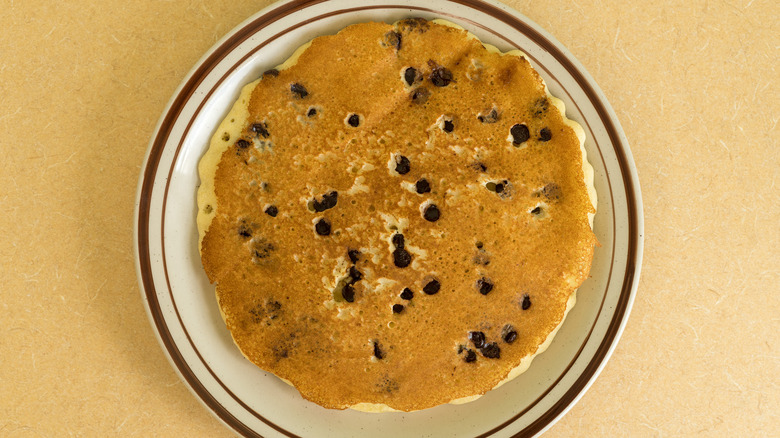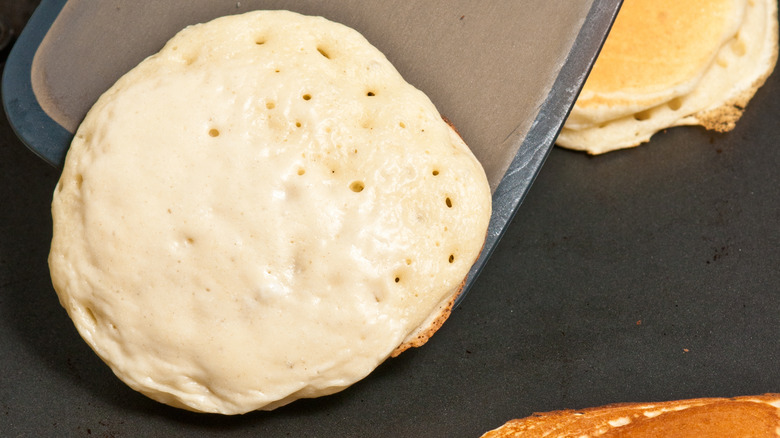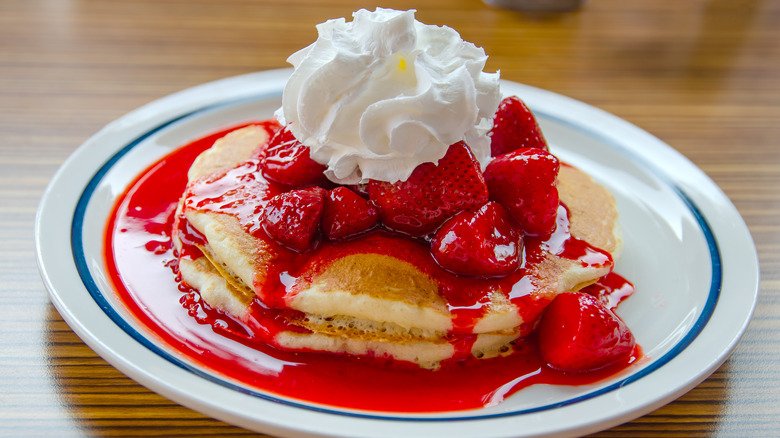14 Tips That Will Make Your Pancakes Taste Like They Came From A Diner
Dreaming of sliding into a booth at your favorite spot and ordering a piping hot buttermilk full stack? If you think there's no way to recreate the iconic American diner pancake at home, we're here to prove that you definitely can.
We've eaten plenty of diner pancakes over the years. But we still fondly recall the short stack we once shared at a busy breakfast spot outside of La Quinta, California. Sure, those griddle cakes were served on 1980s tableware, and they immediately soaked up every last bit of sugary syrup like a desperate sponge, but that was exactly what we came for. That slightly sweet, malt-flavored pancake with melted butter, the way our fork cut into the springy layers — even the chipped mini glass ramekin of syrup that will be forever sticky.
Effortlessly dress up your go-to box mix, or scratch-make them yourself. From gear to griddle, here's how to get that tangy diner pancake flavor, the flawless golden crust, the most tender fluff, and the essential greasy spoon vibe (whipped cream smiley face and cherry nose optional, but highly encouraged).
Get rich with the best possible ingredients
This isn't a time to skimp on the good stuff. Do you think the short-order cook hustling in that hot diner kitchen is messing around with skim milk back there? Nope! Diner pancakes accept no substitutions (vegans and gluten-free fans, continue on as usual. Just know that those types of swaps affect the traditional diner vibe of your pancakes).
Did you see milk listed on the back of the pancake mix box? Go full fat or go home. Whole milk lends a little sweetness to the mix, whereas lighter milk with less fat can spotlight sour undertones. Need an egg or two? Pull a Martha Stewart and harvest them from your own chicken coop. Or, you know, use fresh ones from the fridge.
Quality control is also really important if you're making batter from scratch — especially when it comes to baking soda. It's the stuff that makes the fluff, so you want it to be fresh and ready to rock that voluptuous volume. Can't remember the last time you used your baking soda? You can test its reactivity by adding a teaspoon of baking soda to 3 tablespoons of vinegar. If the mixture gets all fizzy and bubbly, it's good to go.
Malted milk powder gives home cooked pancakes that diner flavor
If we had to choose the world's best tip for making pancakes that taste like they came from a diner, malted milk powder might be our favorite one. This hits the heart and soul of diner-style pancake flavor. And it couldn't be easier to nail.
Most diner kitchens cook their pancakes using a batter that's either malted or fermented, maybe with a sourdough base. That's why, on their own, these special hotcakes feature a bit of malty, tangy sweetness that plays so well with all that syrup we plan on using. Malted milk powder is the not-so-secret ingredient that makes pancakes taste like the ones you ate back in the day.
Malted milk powder is sweet, so you can swap out the sugar in your recipe for up to 3 tablespoons of malted milk powder, per cup of flour. If your Amazon delivery got delayed, you can also try subbing in dark brown sugar for granulated sugar to achieve a similar effect. Just use 1 tablespoon of dark brown sugar for each cup of flour to get maximum flavor.
Room temp ingredients make the fluffiest pancakes
It's totally ok to go by the instructions on the back of the Bisquick box. But just because the ingredients are few (maybe milk, oil, and eggs), doesn't mean they have to be treated to a scurried walk of shame from the fridge to the bowl.
For the fluffiest possible pancakes, room temperature ingredients are clutch. You've probably heard this tip from countless celebrity chefs and cooks (you know, the one where you leave the eggs out overnight for a cake because Ina Garten told you to do it), and it also works for pancakes. It's especially important for the eggs, but also goes for milk, too.
The idea is to achieve a light and even cook. It turns out that cold milk and eggs don't fluff up so well (would you? It's arctic inside the fridge!). But warm ingredients lead to the springy pancakes diners serve. Give yourself some leeway to set out the milk and eggs on the counter ahead of time (about 30 to 60 minutes), and you'll be on your way to fluffy diner pancakes in nothing flat.
Don't just add water if you want pillowy pancakes
We know we said you can just follow a box mix and everything will be fine. Which is true. It's also true that if you want to add a little extra bounce to your stack, you can upgrade your added ingredients. What does water do? Not much. What do egg whites and baking soda do? Magic.
Egg whites add a professional-level fluffiness to your pancakes, like you'd find on a diner menu. And just one extra step yields delicious results. For each cup of pancake mix you're using, whip ⅛ teaspoon of cream of tartar with the whites of one egg. Once you've got stiff peaks, fold the whipped concoction into the batter, and carefully mix until barely incorporated.
No egg whites? No problem. Baking soda combined with an acid, like lemon juice or buttermilk, also does the trick of adding air to your pancakes. Alternatively, baking powder does all the volumizing work itself, as soon as it hits the wet batter.
Extra fat in the batter creates tender pancakes
If anyone here is mad about perfectly tender pancakes, please state your name and which planet you're visiting from. Adding a little oil to your pancake batter does double duty in the flavor and cooking departments.
First, an extra tablespoon or 2 of oil in the batter creates a texture that's less likely to stick onto an ungreased surface, like a cast iron pan. But that extra oil also gets to work encouraging the gluten to just freakin' relax, guy.
Gluten desperately wants to come to life in pancake batter. While we like gluten in bread because it creates that deliciously chewy consistency, it's the opposite of what we want in pancakes. Oil coats the proteins that want to react with water, and keeps them from forming an unappetizing web of rubbery gluten. So your pancake will be tender and cute as a baby lamb, and easier to slide off the griddle.
Krush it with Krusteaz pancake mix
The people of the diner have spoken. Krusteaz Light and Fluffy Buttermilk complete pancake mix is one of the go-to brands of industrial kitchens from Idaho to Alabama. Nail that breakfast counter flavor with an O.G. that's been going strong since the 1940s.
Krusteaz requires only that you add a little water (yep, we might replace that with buttermilk) to get pillowy pancakes that taste like they just dropped out of the clouds. And with ingredients that feature malted barley flour, you won't miss out on that signature malty diner flavor. The texture is springy and tender — a forkful that you won't be able to resist. Even home cooks find the familiar flavor to be in line with their favorite dive restaurant (we have no use for your fancy Belgian waffles here). While we can't actually prove which diner kitchens use Krusteaz mix behind the counter, we know that, at least for us, using it makes ones that taste just like the diner version.
Don't overmix your batter
This one's so much harder to do than it seems. While many of us may have read the directional phrase, "It's okay if the batter is a bit lumpy," we seem to be hard-wired to purée the crap out of anything in a mixing bowl with the nearest utensil. Forking go.
In reality, we really do want the mix to be a little lumpy and bumpy. Overmixing basically triggers the gluten to go wild, turning your batter stiff and rubbery. And, unless you're cooking drink coasters for your coffee table, that's not a texture people usually enjoy eating. It also lets all the air out of the batter (those little bubbles from the leavening ingredients), which then turns your pancakes dense and flat.
There's no need to overthink it. Just put the things in the bowl, stir or whisk for a few turns — until the dry part seems mixed into the wet part — and then stop (phew. Just in time).
Your pancake batter should pour like a diner milkshake
Keeping the diner theme going, in order for the batter to pour smoothly into the pan and spread out into a hefty-sized pancake, it needs to maintain a certain viscosity. And the perfect level of hydration — not too sticky, and not too liquidy — is scientifically termed "Diner milkshake thickness." Hot tip: If you don't remember the thickness of a typical milkshake, a little in-person research is highly recommended. Food Republic said so.
A good test to see if your batter is up to par involves taking a little scoop or twirl of it on your whisk, lifting it above the bowl, and watching how it flows off your spoon. It should move like a silky ribbon. No glops or chunks. And none of that really watery stuff either. But it's no problem if the batter isn't exactly cascading off your whisk. Just add a little buttermilk to thin it out, give it a few stirs, and you're golden.
Let the pancake batter rest before cooking
The practice of batter resting may be one of the most contested topics in the pancake universe. For every chef preaching about absolutely not resting pancake batter, there are even more diner staffers with stories of jugs of batter hanging out on deck for hours, anticipating the morning rush. So, what's the best option? Both, kind of.
Those advocating for a rest period for the batter claim that it allows for starches to form and for the gluten to basically stop flexing its elasticity like it's in a bodybuilding competition. This strategy will then give you pancake batter that fluffs up like a dream. Resting can also allow flavors to deepen, or "marry," if you've added anything extra to the mix like sweet spices for something like cinnamon roll pancakes.
On the flip side, there's an argument to get the show on the road, and not rest the batter at all (other than because we're hungry, of course). Some say holding back your scratch-made batter will only harm those bubbly leavening ingredients. Since they get to work as soon as they hit moisture, they only begin to lose their steam (and deflate) as time goes on, resulting in flat, dense pancakes. If you want to try it, we suggest resting your batter somewhere in the range of 30 minutes to an hour in the fridge, for maximum flavor and ultimate fluffiness.
Fire up homemade diner pancakes with a hot griddle
Get ready for hot griddle summer. A consistently hot griddle is the name of the game when you're churning out pancakes for a crowd. Tragically, there may be no real way to perfectly replicate the classic flat-top diner grill. Of course, you could always install one in your home kitchen, but you would also have to leave it on all the time, and serve thousands of pancakes a day for at least 20 years. Some diner griddles are cranked full tilt 24 hours a day. These surfaces have seen literal years of butter, grease, and oil — and because of that, they're extremely well-seasoned. At home — while it would be a dream come true — we're not exactly flipping pancakes all day. Still, we've got a few tricks up our sleeve to achieve the diner-esque cooktop.
You want a hot surface in a shape that makes it easy to flip pancakes. So crepe pans with a low rim and griddles will be your best bet. Make sure the pan has a thick base to evenly disperse heat and prevent burning and check that it stays heated to a steady temperature. No matter what, learn from that first ugly pancake to come off the pan. It's hideous, but it tells you if the heat is too high, or if there are hot spots on your griddle that you can rotate around as you go. Sigh. That first pancake has a really great personality though.
Cook your pancakes with clarified butter
Craving real, buttery flavor, with zero possible charred pancakes? Skip the oil and cook your pancakes in clarified butter for a golden, buttery finish.
Clarified butter can handle high cooking temperatures without browning, which lets you go for an even cook without any of those dark, semi-fried edges you get from cooking oil. You can buy clarified butter as ghee, or you can make your own with the butter in your fridge. Simply melt it in a saucepan on the stove, untouched, then use a slotted spoon to remove the milk solids that accumulate on top. The clarified butter will be the clear, golden liquid in the middle layer of the pot. Carefully ladle it onto your griddle, and get cookin'.
But. If you really want to go all in on the greasy spoon flavor profile, take a spin on the griddle with Whirl butter flavored oil. According to longtime staffers of dive-type diners, it's a favorite of kitchens using industrial grills. We're not saying you should use it, but we're also not saying you shouldn't. This other-worldly butter substitute just might take you back to the last time you tasted pancakes straight outta IHOP.
Size matters: Diner pancakes are big
Do you want 'em diner-style? This is diner size. There's no room on this griddle for wimpy sand dollar pancakes or any of that mini pancake cereal stuff. The typical diner standard cooks up a pancake that's 8 inches to 10 inches across. It's often similar to the diameter of the plate it's served on. And since diners usually offer solo pancakes a la carte, they make them the size of your head.
This is the main reason why you want a thin batter instead of a super thick one that lands in a lump. You want that batter to spread out evenly, right away. But, if you're not used to flipping the Big Bertha of breakfast foods, a little strategy here works wonders.
Execute the flip like a seasoned diner pro by flipping the pancake with the actual pan. Or, if you prefer pancakes that haven't spent any time on the floor, employ the simple flip of a spatula. One tip that's been floating around via TikTok suggests flipping with your fingers, not your entire wrist, in order to avoid a pancake batter splash zone.
Leave the pancakes alone until they're ready to flip
We, as a civilized people, are the actual worst at leaving pancakes alone while they're cooking. Perfectly-timed flipping appears to be a feat that has yet to be accomplished by a human. But even so, it's the key to a flawless cook.
We're culturally obsessed with sliding the flipper under the pancake edge to see if it's golden long before it's ready. Or trying to shape blobby edges into perfect circles. Ever attempted to flip that little drip of batter in the pan that accidentally created the world's tiniest pancake, while the other ones were still cooking? We see you.
Many of us know in our hearts that we're supposed to wait for golden edges and bubbles on the pancake surface. And yet, we cannot summon that kind of patience. But even more than the appearance of bubbles, we must wait for those bubbles to pop and form lasting craters in the batter, akin to the surface of the moon. That is the exact moment in which to flip your pancake. Of course, no smashing it down once it's flipped. You know who you are. Nope — no gentle patting, either. And no scooching. Listen, just put the flipper down and step away from the pan. Sigh. We try again tomorrow.
Go all in with diner-style aesthetic
Now that we've achieved peak diner pancake, we're going all the way with that diner energy. Not only do we want all of those classic diner flavors, but we want the other diner-y stuff too (whoa, whoa, whoa — not you, useless napkin dispenser).
No diner pancake setup is complete without the ultimate trio of tastiness: Whipped butter, whipped cream, and real, warm, Vermont maple syrup. Don't be coming around here with your brown "pancake syrup" acting like you own the place. You can make your own whipped cream, but we're plenty happy with the store-bought stuff in the can.
Serve these toppings in style with individual 2-ounce syrup pitchers and ramekins. And if you didn't inherit a one-off hand-me-down from someone already, you can pick up what's called "restaurant china," or classic diner serve-ware, that instantly feels like a plate of indestructible nostalgia. "Lollipop" by the Chordettes feels like an on-theme jukebox jam. And — chef's preference — but we might even hook up one of those retro doorbells to jingle every time someone opens the fridge. Oh, and a bell for when each order's ready. It's called vibes, friends.

